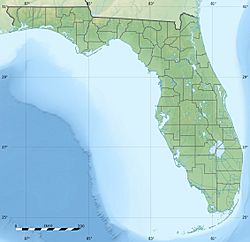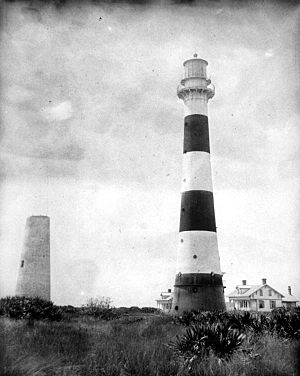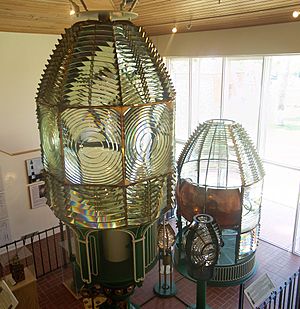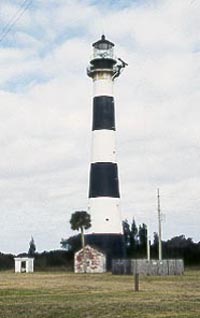Cape Canaveral Light facts for kids
 |
|
| The Cape Canaveral Lighthouse in 2009, after intensive restoration. | |
|
|
|
| Location | one mile inland from Cape Canaveral Florida United States |
|---|---|
| Coordinates | 28°27′37.26″N 80°32′36.42″W / 28.4603500°N 80.5434500°W |
| Year first constructed | 1848 (first) |
| Year first lit | 1868 (current) |
| Automated | 1960 |
| Foundation | brick basement |
| Construction | cast iron plate with brick lining tower |
| Tower shape | tapered cylindrical tower with balcony and lantern |
| Markings / pattern | 1868: white 1873: black and white horizontal bands with white lantern room 1894: black and white horizontal bands with black lantern room |
| Height | 151 feet (46 m) |
| Focal height | 137 feet (42 m) |
| Original lens | first-order Fresnel lens |
| Current lens | DCB-224 (1993) |
| Range | 1st order: 18 nautical miles (33 km; 21 mi) Current: 24 nautical miles (44 km; 28 mi) |
| Characteristic | 1st order: flashing white every minute - flash 5 secs, eclipse 55 secs. Current: Fl (2) W 20s. 0.2s fl 4.8 secs. 0.2s fl 14.8 secs. |
| Admiralty number | J2888 |
| NGA number | 11484 |
| ARLHS number | USA-108 |
| USCG number | 625 |
The Cape Canaveral Light is a historic lighthouse on the east coast of Florida. It was built to warn ships about dangerous shallow areas called shoals near the coast.
This lighthouse is special because it's located inside the Cape Canaveral Space Force Station. The United States Space Force manages it with help from the Cape Canaveral Lighthouse Foundation. It's the only working lighthouse owned by the U.S. Space Force.
The current lighthouse tower is 151-foot (46 m) tall. It was first lit in 1868. Later, it was moved further inland between 1893 and 1894. It used to have a special Fresnel lens that was automated in 1967. This lens was removed in 1993.
Contents
The Cape Canaveral lighthouse was built to keep sailors safe. There are many hidden sandbars and shallow areas, called shoals, off the coast. These shoals can be very dangerous for ships. Sometimes, you can't even see the land from these outer shoals.
The First Lighthouse (1848)
The lighthouse you see today isn't the first one built here. In 1838, people asked for a lighthouse to be built at Cape Canaveral. Nathaniel Scobie was the first lighthouse keeper. He helped build the lighthouse.
The first lighthouse was a 65-foot (20 m) tall white brick tower. It was finished in January 1848. Its light came from 15 special lamps that used whale oil. These lamps were on a spinning chandelier, powered by a clockwork system.
During a time of conflict called the Seminole Wars, the first keeper, Scobie, left his post. In 1853, Captain Mills Olcott Burnham became the next lighthouse keeper. He was also given land as part of a law to help people settle in Florida.
Sailors often complained about this first lighthouse. They said its light was too dim and too low. Ships couldn't see it until they were already too close to the dangerous reefs.
The Second Lighthouse (1868)
In 1860, the government decided to build a new lighthouse. But the American Civil War stopped the work. The keeper, Mills Burnham, even buried the old lighthouse's lamps to protect them from raids.
After the war, building the new lighthouse started again. The new tower was made of cast iron plates. This design meant it could be taken apart and moved if the sea got too close. Inside, it had bricks for strength and to keep it warm or cool.
The new lighthouse was finished in 1868. It stood about 80 to 90 feet (24 to 27 m) from the first tower. It got a powerful Fresnel lens from Paris, France. This light was first turned on in May 1868.
The lower three floors of the tower were living spaces for the keepers. They had a kitchen, living room, and bedrooms. The main entrance was on the third floor. This was to protect it from storm surges during strong hurricanes. This design was tested in 1871 when a big storm flooded the area. The keepers and the lighthouse survived.
In 1873, the white lighthouse tower was painted with its famous black and white stripes. The top part, called the lantern room, stayed white.
However, the iron tower became very hot inside because of Florida's sun and humidity. The keepers often built small shelters outside to escape the heat. In 1876, money was given to build proper homes for the keepers.
Moving the Lighthouse Inland
By the 1880s, the coastline was eroding, meaning the sea was getting closer to the lighthouse. So, the United States Congress decided to move the lighthouse further inland. Work to move it began in October 1893.
While the main lighthouse was being moved, a temporary 55-foot (17 m) tall black tower was put up. This temporary light kept the sea lit for ships.
The very first brick tower (from 1848) was blown up. Its bricks were used to help build the foundation for the lighthouse at its new spot. The iron tower was carefully taken apart. Mules pulled the pieces on a tram to the new location, about a mile west. The keepers' houses were also moved. The whole move took nine months. The lighthouse was relit at its new home on July 25, 1894.
In 1931, the old clockwork system that needed winding every hour or two was replaced. An electric motor now powered the light.
Becoming a Military Facility
In 1949, Cape Canaveral became a military site for testing missiles. People living near the lighthouse had to move. By 1960, the lighthouse light was automated, meaning it didn't need a keeper living there anymore. The keepers' homes were later torn down. Only a small brick oil house remained.
In 1993, the original Fresnel lens was removed. Strong vibrations from rocket launches were damaging its prisms. The lens was sent to a museum for display. A powerful new light, called a DCB-224, replaced it. This new light increased the lighthouse's range to 24 nautical miles (44 km; 28 mi).
In 2000, the United States Coast Guard gave ownership of the lighthouse to the United States Air Force. In 2002, the Cape Canaveral Lighthouse Foundation was created. This group helps take care of the lighthouse.
Head Lighthouse Keepers
Here are some of the main lighthouse keepers who worked at the Cape Canaveral Light:
- Nathaniel C. Scobie 1848 – 1850
- Ora Carpenter 1850 – 1853
- Mills O. Burnham 1853 – 1886
- George M. Quarterman 1886 – 1887
- James M. Knight 1887 – 1893
- John L. Stuck 1893 – 1904
- Clinton P. Honeywell 1904 – 1930
- Oscar F. Quarterman 1930 – 1939
- A. Davis 1939 – at least 1941
Restoration Efforts
From 1995 to 1996, the lighthouse was restored. Old, toxic lead paint was removed. The original copper lantern at the top was replaced with a new one made of galvanized steel. This old copper lantern was then turned into a lighthouse gazebo at the Air Force Space and Missile Museum.
In 2003, the small brick oil house near the lighthouse was restored. Its roof had been damaged by strong winds in the 1970s. A window that was added in the early 1900s was also covered up to make it look like it did in the 1890s.
During 2006-2007, the lighthouse was repainted with modern materials. The original copper lantern was repaired and put back on the lighthouse. The galvanized steel lantern then took its place at the gazebo.
The Lighthouse Today
Today, the Cape Canaveral Lighthouse is open to visitors. It used to be part of the Air Force Space and Missile Museum tours. However, due to budget cuts, the Space Force no longer offers tours.
If you want to visit the lighthouse and the nearby museum, you need to book a tour through the Cape Canaveral Lighthouse Foundation. Visitors can go up to the fifth floor of the lighthouse. The higher floors are considered a safety risk and require special permission to access.
The Cape Canaveral Lighthouse Foundation and its volunteers do a lot of work. They help with restoration projects and teach people about the lighthouse's history. They also plan to restore the three old keeper's cottages for different uses in the future.






